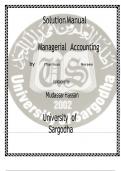Exam (elaborations)
TEST BANK FOR SOLUTION MANUAL MANAGERIAL ACCOUTING 11TH EDITION AL CHAPTERS COMPLETE SOLUTIONS GRADED A+
Course
Managerial jAccounting
Institution
Managerial JAccounting
TEST BANK FOR SOLUTION MANUAL MANAGERIAL ACCOUTING 11TH EDITION ALL CHAPTERS COMPLETE SOLUTIONS GRADED A+
[Show more]
Preview 4 out of 999 pages
Uploaded on
October 30, 2024
Number of pages
999
Written in
2024/2025
Type
Exam (elaborations)
Contains
Questions & answers
Institution
Managerial jAccounting
Course
Managerial jAccounting
$18.49
100% satisfaction guarantee
Immediately available after payment
Both online and in PDF
No strings attached
Solution Manual jj




